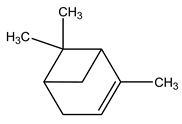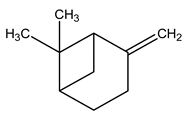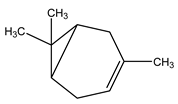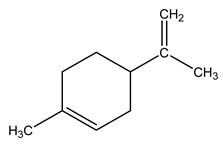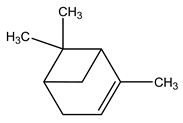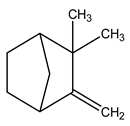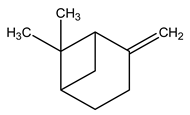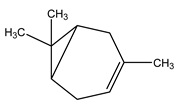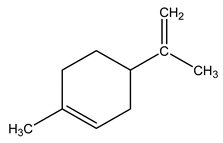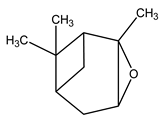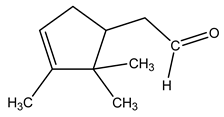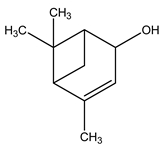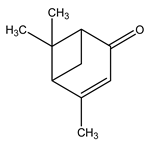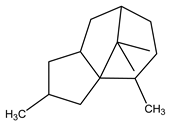Abstract
A study on the application of oxygenated turpentine oil as a bio-additive in diesel fuel was conducted. The purpose of this research was to investigate the effect of oxygenated turpentine oil additive in diesel fuel on the performance and emission characteristics in diesel engines. Oxygenated turpentine oil is obtained from the oxidation process of turpentine oil. In this experimental study, the influences of oxygenated turpentine oil-diesel blended fuel OT0.2 (0.2% vol oxygenated turpentine oil and 99.8% vol diesel) were compared with pure diesel on engine performance, and emission characteristics were examined in a one-cylinder four-stroke CI engine. The test was performed at two engine loads (25% and 50%) and seven engine speeds (from 1200–2400 rpm with intervals of 200 rpm). The physiochemical characteristics of test fuels were acquired. The engine indicated power, indicated torque, fuel flow rate, and emissions (carbon dioxide, CO2; carbon monoxide, CO; and nitrogen oxide, NOX) were examined. The results revealed that the engine power shows slight increments of 0.7–1.1%, whereas the engine torque slightly decreased with oxygenated turpentine usage compared to pure diesel in most conditions. Furthermore, a reduction in NOX emission decreased by about 0.3–66% with the addition of oxygenated turpentine in diesel compared to diesel. However, usage of OT0.2 decreased fuel flow rate in most speeds at low load but gave a similar value to diesel at 50% load. CO emissions slightly increased with an average of 1.2% compared to diesel while CO2 emissions increased up to 37.5% than diesel. The high-water content, low cetane number, and low heating value of oxygenated turpentine oil were the reasons for the inverse effect found in the engine performances.
1. Introduction
Diesel fuel is produced from the distillation process of petroleum and is used to fuel diesel engines. Diesel engine usage has become more popular today ever since it was founded in 1983 by Rudolf Diesel. The popularity of diesel engines comes from the advantage of having a low-cost of fuel compared to gasoline engines. There is a wide use of diesel engines from transportation to industrial applications [1,2,3,4]. As a result, the amount of harmful gas emissions emitted from diesel fuel combustion such as CO, NOX, and hydrocarbon (HC) will be increased as well [5,6,7,8]. Consequently, this has led to adverse impacts on human health and on the environment. For this reason, a lot of studies have been conducted to minimize harmful gases emitted from diesel engines [9,10,11].
Mixing diesel fuel with additives is one of the many attempts to reduce emissions from diesel combustion, as well as a way to optimize fuel consumption of the engine. There are many compounds used as diesel fuel additives such as organometals, nitrates, oxygenates (compounds rich with oxygen), and natural matters (bioactive) [12,13,14,15]. Organometals and nitrates have been known to increase the burning efficiency of diesel fuel. However, it is also discovered that those additives may result in additional emissions of NOX that is harmful to humans [16,17,18]. On the other hand, oxygenates and bio-additives are known to be more environmentally friendly. Nayyar et al. [19] in their recent work stated that the addition of compounds rich in oxygen (oxygenates) into diesel fuel could reduce smoke and NOX production by 61.85% and 8.07%, respectively. This finding was also supported by other research [20,21,22,23], which explained how soot reduction is linearly related to the increasing oxygen mass fraction in the fuel. Other researchers who used oxygenated additives reported enhancement in its application [24,25,26,27].
Turpentine oil is often referred to as spirits of turpentine in the form of volatile liquid, derived from the distillation of tree sap species belonging to the pine genus. It is colorless (liquid), has a distinctive smell, and is flammable [28,29,30]. In general, the physical and chemical properties of boiling turpentine oil is 149–180 °C, insoluble in water, density 0.9, flash point 30–46, auto ignition temperature 220–225 °C (International Program on Chemical Safety and the European Commission, 2002) [31,32,33,34]. It contains monoterpenes with C 10 carbon atoms. Turpentine oil is generally composed of a mixture of unsaturated isomers, bicyclic hydrocarbons namely α-pinene, β-pinene, and δ-carene as presented in Figure 1 [28].

Figure 1.
Chemical structure of the main component of turpentine oil.
From the work of Polonowski et al. [35], it is reported that diesel fuel with 5% of pure turpentine oil could reduce smoke production and reduce fuel consumption. This was in line with Butkus’ finding that 5% of oxidized turpentine oil was the best diesel fuel additive [36,37,38]. Furthermore, Kadarohman et al. [39] found that terpene compounds contained in clove oil (0.2%) were largely contributed to make a better mixture between bio-additive and diesel fuel, which lead to rapid combustion and shorter ignition delay in combustion of diesel engines. This discovery is interesting for further investigation on the influence of terpene compounds addition in diesel fuel [40,41,42].
The four atom C rings on α-pinene and β-pinene have high spatial strain that are reactive. The presence of a double bond causes α-pinene to easily undergo an oxidation reaction when there is air contact, then forms a hydroperoxyl compound which has intermediate molecules that are reactive [43]. The cyclic structure in turpentine oil will effectively disrupt the Van der Waals interaction between the carbon chains of diesel fuel, consequently leading to the diesel oil molecules becoming easier to evaporate, hence accelerating the combustion process [39,44]. The reactive nature of turpentine oil constituents is also expected to accelerate the combustion of diesel fuel. Song et al. [45] suggested that the addition of oxygen enriched additives into diesel fuel has a significant role to increase the cetane number of the fuel. Choi and Reitz [46] mentioned that oxygen atoms in fuel play a major role in oxidizing soot and CO gas.
For this reason, efforts to speed up and to refine the combustion process of diesel fuel can be carried out by enriching the levels of oxygen atoms contained in turpentine oil through the oxidation of the double bonds formed in the compound. In this paper, the effects of additive oxygenated turpentine oil-diesel (0.2% vol and 99.8% vol) on the performance and emission in one-cylinder diesel engines were tested. The experiment was performed at different engine speeds and two engine loads (25% and 50%). The physiochemical characteristics of test fuels were determined. Moreover, the effects of tested fuels upon indicated power, indicated torque, flue flow rate, and emissions characteristics were systematically observed.
2. Materials and Methods
2.1. Materials
In this study, the diesel used was pure diesel Euro2M from Malaysia. Turpentine oil and oxygen gas were from Brataco and Sangkuriang companies, Indonesia. Turpentine oil was oxygenated via the oxidation process. It was carried out by reflux method using a cylindrical column reactor with length and diameter dimensions of 30 cm and 2 cm, respectively. The 15 mL turpentine oil was aerated by oxygen gas with flow rate of 3 L/min and heated by an electrical wire heater at 90–100 °C for 3 h. The oxidation procedure was conducted at Life Science Laboratory, Department of Chemistry, Indonesia University of Education, Bandung Indonesia. Oxygenated turpentine oil as a bio-additive was dissolved in diesel fuel at a volume percent level of 0.2% (note as OT0.2) by a manual direct blending method using a mechanical stirrer IKA RW20 with blending speed 700 rpm for 15 min at room temperature. The characterizations of diesel, turpentine oil, and oxygenated turpentine oil were done by gas chromatography—mass spectrometry GC-MS QP5050A. Diesel fuel and OT0.2 were examined on one-cylinder DI engines in order to obtain their performance and emission.
2.2. Experiment Setup
The test engine was a YANMAR TF120M one-cylinder DI diesel engine with a 17.7 compression ratio. The specifications of the engine and schematic diagram of the set up for this test are shown in Table 1 and Figure 2, respectively. The data were recorded by data acquisition system TFX Engineering, which consisted of in-cylinder pressure and crank angle sensors. Furthermore, exhaust gas temperature and ambient temperature were measured using K-type thermocouples, that were recorded using a TC-08 thermocouple data logger by Pico Technology. The thermocouple was installed at the exhaust manifold. The emissions were measured using KANE Auto 4-1 series exhaust gas analysers. The experiment was conducted with seven speeds from 1200 to 2400 rpm with intervals of 200 rpm and two engine loads at 25% and 50%. The test fuels used were diesel as base line and oxygenated turpentine oil-diesel (0.2% vol and 99.8% vol). The data were recorded under steady state conditions. The engine power, engine torque, the fuel flow rate, and the emissions (CO, CO2, and NOx) were measured. The experiment was conducted at Universiti Malaysia Pahang (UMP), Kuantan, Malaysia.

Table 1.
Engine Specifications.
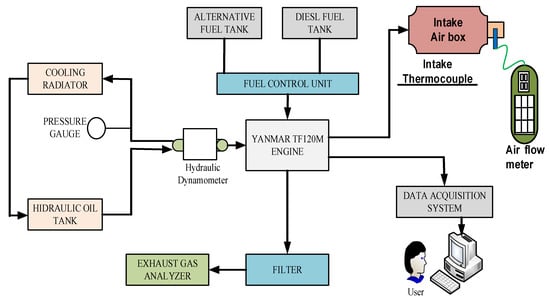
Figure 2.
Schematic diagram of diesel engine test set up.
3. Results and Discussion
3.1. Physiochemical Properties
The performed research on physical properties showed that the bio-additive fuel blends were in full compliance with the standard of American Society for Testing and Materials, ASTM D975 specifications for diesel fuel. The physical properties of diesel and OT0.2 were presented in Table 2.

Table 2.
Physical properties of test fuels.
The diesel, turpentine, and oxygenated enriched turpentine used in this experiment were characterized by GC-MS. Figure 3 shows the chromatogram of diesel fuel, turpentine, and oxygenated turpentine that provides the information of its chemical components and composition. In particular, diesel fuel consisted of saturated hydrocarbons such as normal paraffins, is paraffins, and cycloparaffins. The main components of diesel fuel are hexadecane (n-cetane), pristane (2,6,10,14-tetramethylpentadecane), and is paraffins (Figure 3a), in line with previous studies [47]. The chemical constituents of diesel fuel are listed in Table 3.
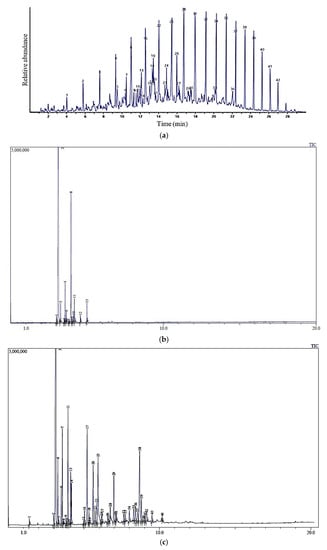
Figure 3.
Chromatogram of diesel fuel (a), turpentine (b), and oxygenated turpentine (c).

Table 3.
Chemical constituents of diesel fuel.
On the other hand, turpentine contains at least 12 compounds as shown in Figure 3b, that are predominantly composed of α-pinene (61.61%), δ-carene (19.70%), β-pinene (4.8%), limonene (3.58%), and camphene (2.25%), with based mass fragment at retention times of 3.127, 3.950, 3.568, 4.712 and 3.267 min, respectively. These results align with previous studies [48]. All chemical compounds of turpentine including its structure and composition is listed in Table 4.

Table 4.
Major chemical constituents of turpentine.
Interestingly, oxidation treatment led to remarkable modifications of turpentine in term of chemical constituents and composition. Figure 3c demonstrates the chemical constituents of oxygenated turpentine where at least 44 compounds were detected by GCMS. In particular, the oxidation process of turpentine yields new compounds with various composition. After oxidation, the composition of major constituents of turpentine experienced a significant reduction, i.e., α-pinene (32.68%), δ-carene (5.77%), β-pinene (4.44%), and limonene (1.93%). This presents new oxygenated compounds with significant composition such as α-pinene-oxide, patchcoulane, trans-verbenol, verbenone, and α-champholene aldehyde at retention times of 5.213, 8.684, 5.932, 6.974, and 5.604, respectively. Details of chemical constituents of oxygenated turpentine are summarized in Table 5. Additionally, the mass fragment of major chemical components of oxygenated turpentine is shown in Figure 4. The oxygenated products contain more oxygen related functional groups, i.e., hydroxyl (-OH), aldehyde (-HC=O), and ketone (-C=O). These results indicated the effectiveness of selected oxidation procedures of turpentine where the predominant oxygenated compounds came from the oxidation of α-pinene and δ-carene as the most major constituents of turpentine.

Table 5.
Major chemical constituents of oxygenated turpentine.

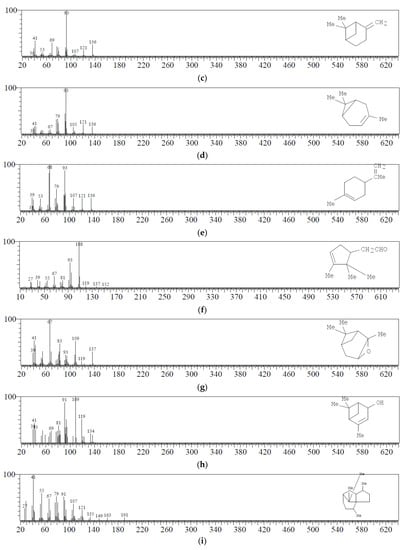
Figure 4.
Mass fragments of α-pinene (a), camphene (b), β-pinene (c), δ-carene (d), limonene (e), α-champholene aldehyde (f), α-pinene oxide (g), trans-verbenol (h), and Patchoulane (i) for oxygenated turpentine.
3.2. Engine Performance
Figure 5 and Figure 6 show comparison results of indicated power and indicated torque at various engine speeds and loads, respectively. The power and torque depended on the fuel supplied and engine operating conditions. In this study, at the maximum engine speed of 2400 rpm, the indicated power of the engine slightly increased with the addition of an oxygenated additive compared to diesel fuel. The average increment when an additive was introduced into diesel was 0.7% to 1.1%. The higher oxygen content in oxygenated turpentine improved the in-cylinder combustion reaction process, hence producing higher power than diesel [33,49,50]. Another reason is due to higher fuel mass flow used for additive fuel. The increments were supported by a few studies that used oxygenated additives in the fuel [51,52,53]. On the other hand, the torque profile for low and high loads of oxygenated turpentine was found to be lower than diesel. The decrement is due to the increase in mass and flow resistance and the decrease in volumetric efficiency [33,54].
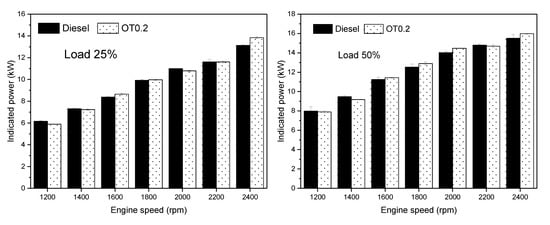
Figure 5.
Indicated power at various engine speeds.
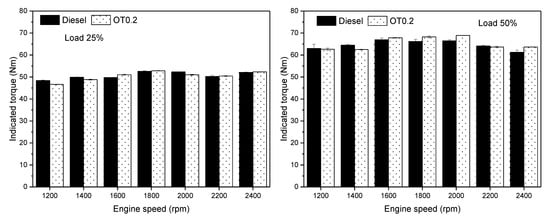
Figure 6.
Indicated torque at various engine speeds.
Figure 7 presents the variations of fuel flow rates at different speeds and loads for diesel and oxygenated turpentine oil-diesel fuel. Mostly, the flow rate increases with the increment of engine speed and load. At low load cases, at most engine speeds, there are decrement of fuel flow rate of additive fuel compared to diesel. The enhancement rate of fuel flow while using an additive are between 5 to 9.09% compared to diesel. However, at 50% load, oxygenated turpentine oil-diesel fuel shows a slight increment of fuel flow rates with diesel at most engine speeds. The percentage of increment of fuel flow rate while using an additive at 50% load are in the range of 0.42 to 10.67%, compared to diesel. It is due to the lower heating value of oxygenated turpentine oil—diesel that requires higher fuel consumption. In contrast, at medium load with high speeds, 2200 and 2400 rpm, fuel flow rate of oxygenated turpentine oil-diesel fuel shows reduction up to 4.6% compared to diesel.
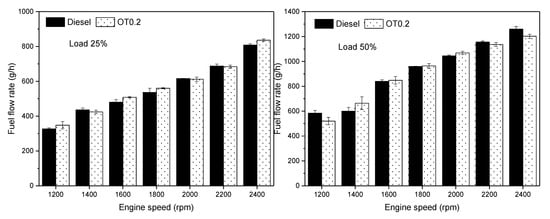
Figure 7.
Fuel flow rate at various engine speeds.
3.3. Gas Emissions
In general, carbon monoxide emission shows a decline pattern when oxygenated additives are introduced into diesel fuel [55,56,57]. Reduction in CO occurs due to oxygenated characteristics of fuel and well-flammability properties of the oxygenated additive. Furthermore, the higher latent heat of evaporation in oxygenated-based fuels compared to diesel allows lower intake of manifold temperature and enhances the volumetric efficiency [58,59,60]. Figure 8 presents variations in CO emission emitted from the combustion diesel engine using diesel and oxygenated turpentine oil-diesel fuel. In this study, the lowest value of CO emission was found at low engine speeds for both engine loads. Mostly, an increase in engine speed leads to an increase in CO emission. In most operating conditions, CO emission shows a slight increment of 1.2% on average compared to diesel. This is parallel with previous statements. Several studies also reported the same decrements relative to diesel fuel when oxygenated fuel was added into diesel [61,62,63,64]. However, at 1600 rpm engine speed, the percentage of CO was increased for both load cases.
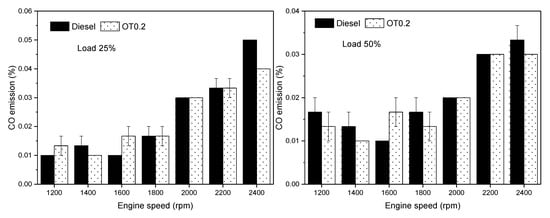
Figure 8.
CO emission at various engine speeds.
CO2 emission is a product of complete combustion. Theoretically, the combustion of hydrocarbon-based fuel should form only two elements, namely CO2 and H2O. Figure 9 shows the CO2 emissions for diesel and oxygenated turpentine oil-diesel fuel at low and medium loads. For both load cases, there are slight increments of CO2 emissions compared to diesel at most engine speeds. The average increment was 0–37.5% and 0–18% for 25% load and 50% load, respectively. The increase in CO2 emissions compared to diesel fuel is due to higher average carbon content per energy in oxygenated turpentine. The high oxygen content of additives also leads to an increment of CO2. The increment aligns with the reported studies [22,56,65].
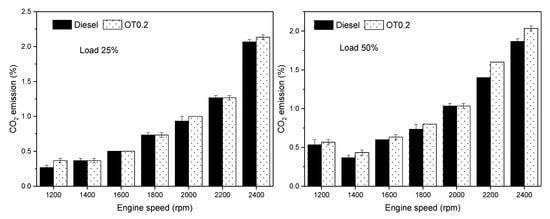
Figure 9.
CO2 emission at various engine speeds.
The major concern of emissions from compression ignition engines is NOX. Formation of NOX is strongly related to combustion temperature. It is also connected to engine operation conditions including engine speeds and engine loads, as well as fuel-to-air ratio. Nitrogen reacts with oxygen inside the combustion chamber at high temperatures. At temperatures above 1600 °C, NOX formation occurs and increases rapidly with increments of temperature [66]. Moreover, NOX formation happens in the presence of CH radicals at the flame front [67,68,69]. In this study, generally, there are slight increments of NOX emission using additives compared to diesel as shown in Figure 10. At 25% load, the range of increment for NOX emission was 0.5–66% compared to diesel. At 50% load, increments of NOX emission was 0.3–7.9% relative to diesel. The increment of NOX formation is due to higher oxygen content in oxygenated turpentine oil-diesel fuel compared to diesel fuel. A similar finding was reported on oxygenated fuel addition in diesel [56,70].
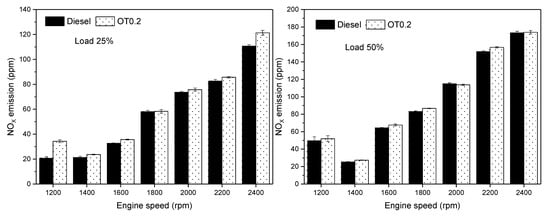
Figure 10.
NOX emission at various engine speeds.
4. Conclusions
The performance and emission of a one-cylinder DI engine using pure diesel and oxygenated turpentine oil-diesel (0.2% vol and 99.8% vol) blend was studied. The addition of oxygenated turpentine into diesel affected the physicochemical properties of the blends including specific gravity, density, aniline point, viscosities, flash point, and stability. The acquired results lead to major conclusions as drawn below.
- The engine power shows slight increments, 0.7–1.1%, whereas the engine torque was slightly decreased using oxygenated turpentine oil-diesel fuel compared to diesel fuel in most conditions.
- The fuel flow rate was lower for OT0.2 compared to diesel in most conditions for low load. The enhancement rate of fuel flow while using an additive is between 5 and 9.09 percent.
- CO emission shows a slight increment when OT0.2 was used, 1.2% on average compared to diesel.
- CO2 emission increases with OT0.2 usage in diesel fuel up to 37.5%.
- NOX emission decreased by about 0.3–66% in addition to oxygenated turpentine in diesel compared to diesel fuel.
Therefore, there are a few recommendations for future work and research that could improve and broaden the scope of this experiment. The following suggestions could be used to improve and gain a better understanding of the additive’s performance and emission.
- The load applied to the engine could be increased to a high-level load;
- For wider understanding of the effect of oxygenated turpentine to the performance and emission, a larger volume of additive could be tested;
- The application of the additive could be tested in higher power and different types of engines.
Author Contributions
Conceptualization, F.K.; methodology, S.S. and E.; validation, A.K., R.E.S. and F.K.; formal analysis, I.I.; resources, H.; writing—original draft preparation, S.S.; writing—review and editing, E.; supervision, R.M. and A.F.Y.; project administration, T.Y.; funding acquisition, A.K. All authors have read and agreed to the published version of the manuscript.
Funding
This research was funded by the Ministry of Research, Technology, and Higher Education of Indonesia for the competitive grant of World Class Professor (WCP) program scheme–A (No.123.2/D2.3/KP/2018) and University Malaysia Pahang (UMP) for financial support through the short-term research grant scheme (RDU172204, RDU130131, RDU1703314 and RDU1603126).
Institutional Review Board Statement
Not applicable.
Informed Consent Statement
Not applicable.
Data Availability Statement
Not applicable.
Conflicts of Interest
The authors declare no conflict of interest.
Nomenclature
| OT0.2 | Diesel fuel + 0.2% of oxygenated turpentine oil |
| CO | Carbon monoxide |
| CO2 | Carbon dioxide |
| NOX | Nitrogen oxides |
| HC | Hydro carbons |
| DI | Direct injection |
References
- Kaimal, V.K.; Vijayabalan, P. A study on synthesis of energy fuel from waste plastic and assessment of its potential as an alternative fuel for diesel engines. Waste Manag. 2016, 51, 91–96. [Google Scholar] [CrossRef]
- Jayed, M.; Masjuki, H.; Kalam, M.; Mahlia, T.; Husnawan, M.; Liaquat, A. Prospects of dedicated biodiesel engine vehicles in Malaysia and Indonesia. Renew. Sustain. Energy Rev. 2011, 15, 220–235. [Google Scholar] [CrossRef]
- Pilusa, T.J. The use of modified tyre derived fuel for compression ignition engines. Waste Manag. 2017, 60, 451–459. [Google Scholar] [CrossRef]
- Faussone, G.C. Transportation fuel from plastic: Two cases of study. Waste Manag. 2018, 73, 416–423. [Google Scholar] [CrossRef] [PubMed]
- Shim, E.; Park, H.; Bae, C. Intake air strategy for low HC and CO emissions in dual-fuel (CNG-diesel) premixed charge compression ignition engine. Appl. Energy 2018, 225, 1068–1077. [Google Scholar] [CrossRef]
- Ospina, G.; Selim, M.Y.; Al Omari, S.A.; Ali, M.I.H.; Hussien, A.M. Engine roughness and exhaust emissions of a diesel engine fueled with three biofuels. Renew. Energy 2018, 134, 1465–1472. [Google Scholar] [CrossRef]
- Amin, N.A.S.; Talebian-Kiakalaieh, A. Reduction of CO2 emission by INCAM model in Malaysia biomass power plants during the year 2016. Waste Manag. 2018, 73, 256–264. [Google Scholar] [CrossRef] [PubMed]
- Jensen, M.B.; Møller, J.; Mønster, J.; Scheutz, C. Quantification of greenhouse gas emissions from a biological waste treatment facility. Waste Manag. 2017, 67, 375–384. [Google Scholar] [CrossRef] [PubMed]
- How, H.; Masjuki, H.; Kalam, M.; Teoh, Y.; Chuah, H. Effect of Calophyllum Inophyllum biodiesel-diesel blends on combustion, performance, exhaust particulate matter and gaseous emissions in a multi-cylinder diesel engine. Fuel 2018, 227, 154–164. [Google Scholar] [CrossRef]
- Hupponen, M.; Grönman, K.; Horttanainen, M. Areas on which to focus when seeking to reduce the greenhouse gas emissions of commercial waste management. A case study of a hypermarket, Finland. Waste Manag. 2018, 76, 1–18. [Google Scholar] [CrossRef]
- Röder, M.; Thornley, P. Waste wood as bioenergy feedstock. Climate change impacts and related emission uncertainties from waste wood based energy systems in the UK. Waste Manag. 2018, 74, 241–252. [Google Scholar] [CrossRef] [Green Version]
- Pan, M.; Huang, R.; Liao, J.; Ouyang, T.; Zheng, Z.; Lv, D.; Huang, H. Effect of EGR dilution on combustion, performance and emission characteristics of a diesel engine fueled with n-pentanol and 2-ethylhexyl nitrate additive. Energy Convers. Manag. 2018, 176, 246–255. [Google Scholar] [CrossRef]
- Allen, E.; Browne, J.; Hynes, S.; Murphy, J.D. The potential of algae blooms to produce renewable gaseous fuel. Waste Manag. 2013, 33, 2425–2433. [Google Scholar] [CrossRef]
- Karmee, S.K. A spent coffee grounds based biorefinery for the production of biofuels, biopolymers, antioxidants and biocomposites. Waste Manag. 2018, 72, 240–254. [Google Scholar] [CrossRef] [PubMed]
- Wang, Y.; Dai, L.; Fan, L.; Cao, L.; Zhou, Y.; Zhao, Y.; Liu, Y.; Ruan, R. Catalytic co-pyrolysis of waste vegetable oil and high density polyethylene for hydrocarbon fuel production. Waste Manag. 2017, 61, 276–282. [Google Scholar] [CrossRef] [PubMed]
- da Silva, M.A.V.; Ferreira, B.L.G.; Marques, L.G.d.; Murta, A.L.S.; de Freitas, M.A.V. Comparative study of NOx emissions of biodiesel-diesel blends from soybean, palm and waste frying oils using methyl and ethyl transesterification routes. Fuel 2017, 194, 144–156. [Google Scholar] [CrossRef]
- El Sheikh, K.; Khan, M.J.H.; Hamid, M.D.; Shrestha, S.; Ali, B.S.; Ryabov, G.A.; Dolgushin, L.A.; Hussain, M.A.; Bukharkina, T.V.; Golerova, E.A. Advances in reduction of NOx and N2O emission formation in an oxy-fired fluidized bed boiler. Chin. J. Chem. Eng. 2018, 27, 426–443. [Google Scholar] [CrossRef]
- Hu, N.; Tan, J.; Wang, X.; Zhang, X.; Yu, P. Volatile organic compound emissions from an engine fueled with an ethanol-biodiesel-diesel blend. J. Energy Inst. 2017, 90, 101–109. [Google Scholar] [CrossRef]
- Nayyar, A.; Sharma, D.; Soni, S.L.; Bhardwaj, B.; Augustine, M. Modeling and experimental investigation for performance and emissions on a diesel engine using bio-oxygenated ternary fuel blends. Energy 2019, 168, 136–150. [Google Scholar] [CrossRef]
- Manigandan, S.; Gunasekar, P.; Devipriya, J.; Nithya, S. Emission and injection characteristics of corn biodiesel blends in diesel engine. Fuel 2019, 235, 723–735. [Google Scholar] [CrossRef]
- Mueller, C.J.; Pitz, W.J.; Pickett, L.M.; Martin, G.C.; Siebers, D.L.; Westbrook, C.K. Effects of Oxygenates on Soot Processes in DI Diesel Engines: Experiments and Numerical Simulations; SAE Technical Paper 0148-7191; SAE International: Warrendale, PA, USA, 2003. [Google Scholar]
- Awad, O.I.; Mamat, R.; Ali, O.M.; Yusri, I.M.; Abdullah, A.A.; Yusop, A.F.; Noor, M.M. The effect of adding fusel oil to diesel on the performance and the emissions characteristics in a single cylinder CI engine. J. Energy Inst. 2017, 90, 382–396. [Google Scholar] [CrossRef] [Green Version]
- Couth, R.; Trois, C. Carbon emissions reduction strategies in Africa from improved waste management: A review. Waste Manag. 2010, 30, 2336–2346. [Google Scholar] [CrossRef] [PubMed]
- Damodharan, D.; Sathiyagnanam, A.P.; Rana, D.; Saravanan, S.; Kumar, B.R.; Sethuramasamyraja, B. Effective utilization of waste plastic oil in a direct injection diesel engine using high carbon alcohols as oxygenated additives for cleaner emissions. Energy Convers. Manag. 2018, 166, 81–97. [Google Scholar] [CrossRef]
- Chong, C.T.; Ng, J.-H.; Ahmad, S.; Rajoo, S. Oxygenated palm biodiesel: Ignition, combustion and emissions quantification in a light-duty diesel engine. Energy Convers. Manag. 2015, 101, 317–325. [Google Scholar] [CrossRef]
- Ahmed, S.; Krumpelt, M. Hydrogen from hydrocarbon fuels for fuel cells. Int. J. Hydrog. Energy 2001, 26, 291–301. [Google Scholar] [CrossRef]
- Szybist, J.P.; Song, J.; Alam, M.; Boehman, A.L. Biodiesel combustion, emissions and emission control. Fuel Process. Technol. 2007, 88, 679–691. [Google Scholar] [CrossRef]
- Sastrohamidjojo, H. Kimia Minyak Atsiri; Universitas Gadjah Mada: Yogyakarta, Indonesia, 2004. [Google Scholar]
- Dubey, P.; Gupta, R. Influences of dual bio-fuel (Jatropha biodiesel and turpentine oil) on single cylinder variable compression ratio diesel engine. Renew. Energy 2018, 115, 1294–1302. [Google Scholar] [CrossRef]
- Dubey, P.; Gupta, R. Effects of dual bio-fuel (Jatropha biodiesel and turpentine oil) on a single cylinder naturally aspirated diesel engine without EGR. Appl. Therm. Eng. 2017, 115, 1137–1147. [Google Scholar] [CrossRef]
- Karthikeyan, R.; Mahalakshmi, N.V. Performance and emission characteristics of a turpentine–diesel dual fuel engine. Energy 2007, 32, 1202–1209. [Google Scholar] [CrossRef]
- Esplugas, S.; Bila, D.M.; Krause, L.G.T.; Dezotti, M. Ozonation and advanced oxidation technologies to remove endocrine disrupting chemicals (EDCs) and pharmaceuticals and personal care products (PPCPs) in water effluents. J. Hazard. Mater. 2007, 149, 631–642. [Google Scholar] [CrossRef]
- Anand, B.P.; Saravanan, C.; Srinivasan, C.A. Performance and exhaust emission of turpentine oil powered direct injection diesel engine. Renew. Energy 2010, 35, 1179–1184. [Google Scholar] [CrossRef]
- Anandavelu, K.; Alagumurthi, N.; Saravanan, C. Performance and emission evaluation of low heat rejection direct injection diesel engine fueled by diesel–turpentine oil blends. In Proceedings of the ASME 2010 International Mechanical Engineering Congress and Exposition, Vancouver, BC, Canada, 12–18 November 2010; pp. 1581–1587. [Google Scholar]
- Polonowski, C.J.; Mathur, V.K.; Naber, J.; Blough, J.R. Accelerometer Based Sensing of Combustion in a High Speed HPCR Diesel Engine; SAE Technical Paper 0148-7191; SAE International: Warrendale, PA, USA, 2007. [Google Scholar]
- Akbarian, E.; Najafi, B. A novel fuel containing glycerol triacetate additive, biodiesel and diesel blends to improve dual-fuelled diesel engines performance and exhaust emissions. Fuel 2019, 236, 666–676. [Google Scholar] [CrossRef]
- Jiaqiang, E.; Zhang, Z.; Chen, J.; Pham, M.; Zhao, X.; Peng, Q.; Zhang, B.; Yin, Z. Performance and emission evaluation of a marine diesel engine fueled by water biodiesel-diesel emulsion blends with a fuel additive of a cerium oxide nanoparticle. Energy Convers. Manag. 2018, 169, 194–205. [Google Scholar]
- Butkus, A.; Pukalskas, S.; Bogdanovičius, Z. The influence of turpentine additive on the ecological parameters of diesel engines. Transport 2007, 22, 80–82. [Google Scholar] [CrossRef] [Green Version]
- Kadarohman, A.; Khoerunisa, F.H.; Astuti, R.M. Potency of clove oil and turpentine oil as a diesel fuel bioadditives and their performance on one cylinder engine. In Proceedings of the International Seminar on Chemistry, Jatinangor, Indonesia, 30–31 October 2008; pp. 30–31. [Google Scholar]
- Godiño, J.A.V.; Aguilar, F.J.J.-E.; García, M.T. Simulation of HCCI combustion in air-cooled off-road engines fuelled with diesel and biodiesel. J. Energy Inst. 2018, 91, 549–562. [Google Scholar] [CrossRef]
- Bednarski, M.; Orliński, P.; Wojs, M.K.; Sikora, M. Evaluation of methods for determining the combustion ignition delay in a diesel engine powered by liquid biofuel. J. Energy Inst. 2018, 92, 1107–1114. [Google Scholar] [CrossRef]
- Kannan, M.; Karthikeyan, R.; Deepanraj, B.; Baskaran, R. Feasibility and performance study of turpentine fueled DI diesel engine operated under HCCI combustion mode. J. Mech. Sci. Technol. 2014, 28, 729–737. [Google Scholar] [CrossRef]
- Berndt, T.; Böge, O.; Stratmann, F. Gas-phase ozonolysis of α-pinene: Gaseous products and particle formation. Atmos. Environ. 2003, 37, 3933–3945. [Google Scholar] [CrossRef]
- Kadarohman, A.; Rohman, I.; Kusrini, R.; Astuti, R.M. Combustion characteristics of diesel fuel on one cylinder diesel engine using clove oil, eugenol, and eugenyl acetate as fuel bio-additives. Fuel 2012, 98, 73–79. [Google Scholar] [CrossRef]
- Song, J.; Cheenkachorn, K.; Wang, J.; Perez, J.; Boehman, A.L.; Young, P.J.; Waller, F.J. Effect of oxygenated fuel on combustion and emissions in a light-duty turbo diesel engine. Energy Fuels 2002, 16, 294–301. [Google Scholar] [CrossRef]
- Choi, C.-Y.; Reitz, R.D. An experimental study on the effects of oxygenated fuel blends and multiple injection strategies on DI diesel engine emissions. Fuel 1999, 78, 1303–1317. [Google Scholar] [CrossRef]
- Fuel, D. Diesel Fuel And Exhaust Emissions; WHO Library Cataloguing: Geneva, Switzerland, 1996. [Google Scholar]
- Jonsson, Å.M.; Hallquist, M.; Ljungström, E. Impact of humidity on the ozone initiated oxidation of limonene, Δ3-carene, and α-pinene. Environ. Sci. Technol. 2006, 40, 188–194. [Google Scholar] [CrossRef] [PubMed]
- Singh, P.; Chauhan, S.; Goel, V. Assessment of diesel engine combustion, performance and emission characteristics fuelled with dual fuel blends. Renew. Energy 2018, 125, 501–510. [Google Scholar] [CrossRef]
- Tamilselvan, P.; Nallusamy, N.; Rajkumar, S. A comprehensive review on performance, combustion and emission characteristics of biodiesel fuelled diesel engines. Renew. Sustain. Energy Rev. 2017, 79, 1134–1159. [Google Scholar] [CrossRef]
- Soudagar, M.E.M.; Nik-Ghazali, N.-N.; Kalam, M.A.; Badruddin, I.; Banapurmath, N.; Akram, N. The effect of nano-additives in diesel-biodiesel fuel blends: A comprehensive review on stability, engine performance and emission characteristics. Energy Convers. Manag. 2018, 178, 146–177. [Google Scholar] [CrossRef]
- Vigneswaran, R.; Annamalai, K.; Dhinesh, B.; Krishnamoorthy, R. Experimental investigation of unmodified diesel engine performance, combustion and emission with multipurpose additive along with water-in-diesel emulsion fuel. Energy Convers. Manag. 2018, 172, 370–380. [Google Scholar] [CrossRef]
- Sahoo, R.R.; Jain, A. Experimental analysis of nanofuel additives with magnetic fuel conditioning for diesel engine performance and emissions. Fuel 2019, 236, 365–372. [Google Scholar] [CrossRef]
- Och, S.H.; Moura, L.M.; Mariani, V.C.; Coelho, L.d.S.; Velasquez, J.A.; Domingues, E. Volumetric efficiency optimization of a single-cylinder DI diesel engine using differential evolution algorithm. Appl. Therm. Eng. 2016, 108, 660–669. [Google Scholar] [CrossRef]
- Huang, H.; Li, Z.; Teng, W.; Zhou, C.; Huang, R.; Liu, H.; Pan, M. Influence of n-butanol-diesel-PODE3-4 fuels coupled pilot injection strategy on combustion and emission characteristics of diesel engine. Fuel 2019, 236, 313–324. [Google Scholar] [CrossRef]
- Örs, I.; Sarıkoç, S.; Atabani, A.; Ünalan, S.; Akansu, S. The effects on performance, combustion and emission characteristics of DICI engine fuelled with TiO2 nanoparticles addition in diesel/biodiesel/n-butanol blends. Fuel 2018, 234, 177–188. [Google Scholar] [CrossRef]
- Yadav, A.K.; Dewangan, A.; Mallick, A. Effect of n-Butanol and Diethyl Ether on Performance and Emission Characteristics of a Diesel Engine Fueled with Diesel–Pongamia Biodiesel Blend. J. Energy Eng. 2018, 144, 4018062. [Google Scholar] [CrossRef]
- Basha, J.S. Impact of Carbon Nanotubes and Di-Ethyl Ether as additives with biodiesel emulsion fuels in a diesel engine–An experimental investigation. J. Energy Inst. 2016, 91, 289–303. [Google Scholar] [CrossRef]
- Sharma, G.; Lal, H. Effects of ethanol-gasoline blends on engine performance and exhaust emissions in a spark ignition. Int. J. Emerg. Technol. 2015, 6, 184. [Google Scholar]
- Bilgin, A.; Durgun, O.; Sahin, Z. The effects of diesel-ethanol blends on diesel engine performance. Energy Sources 2002, 24, 431–440. [Google Scholar] [CrossRef]
- Jamrozik, A.; Tutak, W.; Pyrc, M.; Gruca, M.; Kočiško, M. Study on co-combustion of diesel fuel with oxygenated alcohols in a compression ignition dual-fuel engine. Fuel 2018, 221, 329–345. [Google Scholar] [CrossRef]
- Hagos, F.Y.; Ali, O.M.; Mamat, R.; Abdullah, A.A. Effect of emulsification and blending on the oxygenation and substitution of diesel fuel for compression ignition engine. Renew. Sustain. Energy Rev. 2017, 75, 1281–1294. [Google Scholar] [CrossRef] [Green Version]
- Redel-Macías, M.; Pinzi, S.; Leiva-Candia, D.; López, I.; Dorado, M. Ternary blends of diesel fuel oxygenated with ethanol and castor oil for diesel engines. Energy Procedia 2017, 142, 855–860. [Google Scholar] [CrossRef]
- Park, W.; Park, S.; Reitz, R.D.; Kurtz, E. The effect of oxygenated fuel properties on diesel spray combustion and soot formation. Combust. Flame 2017, 180, 276–283. [Google Scholar] [CrossRef] [Green Version]
- Algayyim, S.J.M.; Wandel, A.P.; Yusaf, T.; Al-Lwayzy, S.; Hamawand, I. Impact of butanol-acetone mixture as a fuel additive on diesel engine performance and emissions. Fuel 2018, 227, 118–126. [Google Scholar] [CrossRef]
- Cybulski, A.; Moulijn, J.A. Structured Catalysts and Reactors; CRC: Boca Raton, FL, USA, 2005. [Google Scholar]
- Naha, S.; Aggarwal, S.K. Fuel effects on NOx emissions in partially premixed flames. Combust. Flame 2004, 139, 90–105. [Google Scholar] [CrossRef]
- Winer, W.O.; Bergles, A.E.; Klutke, G.A.; Wang, K.K.; Finnie, I.; Welty, J.R.; Bryant, M.D.; Yang, H.T.; Mow, V.C.; Leckie, F.A. Nanoindentation; Mechanical Engineering Series; Springer: New York, NY, USA, 2011. [Google Scholar]
- Balaji, G.; Cheralathan, M. Study of antioxidant effect on oxidation stability and emissions in a methyl ester of neem oil fuelled DI diesel engine. J. Energy Inst. 2014, 87, 188–195. [Google Scholar] [CrossRef]
- Huang, H.; Liu, Q.; Teng, W.; Pan, M.; Liu, C.; Wang, Q. Improvement of combustion performance and emissions in diesel engines by fueling n-butanol/diesel/PODE3–4 mixtures. Appl. Energy 2018, 227, 38–48. [Google Scholar] [CrossRef]
Publisher’s Note: MDPI stays neutral with regard to jurisdictional claims in published maps and institutional affiliations. |
© 2021 by the authors. Licensee MDPI, Basel, Switzerland. This article is an open access article distributed under the terms and conditions of the Creative Commons Attribution (CC BY) license (https://creativecommons.org/licenses/by/4.0/).



